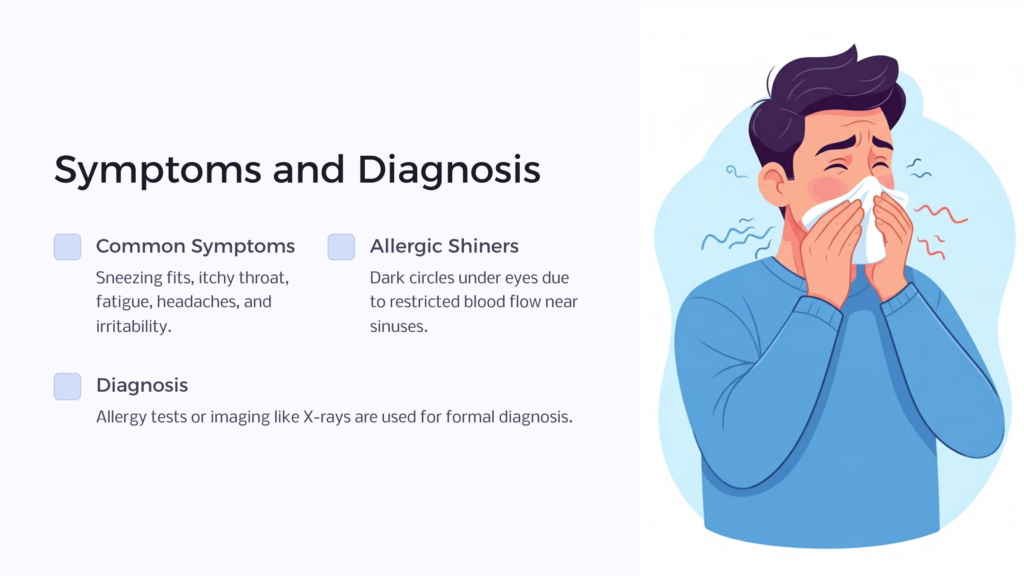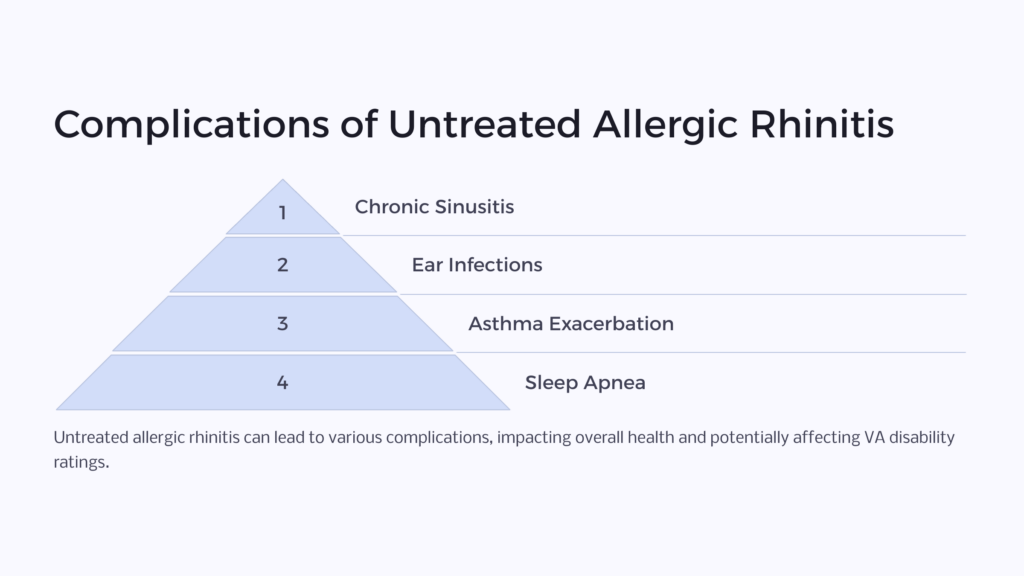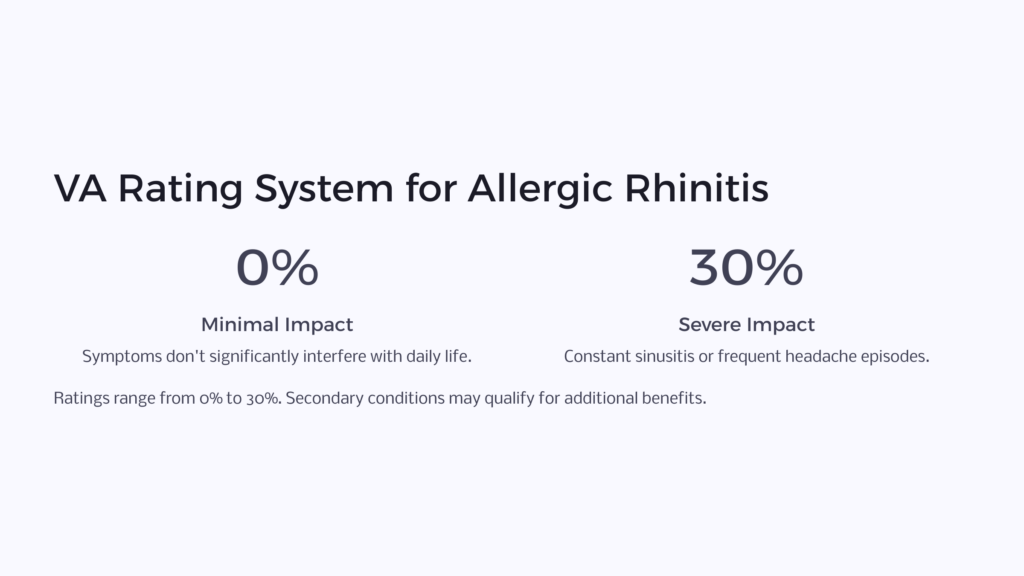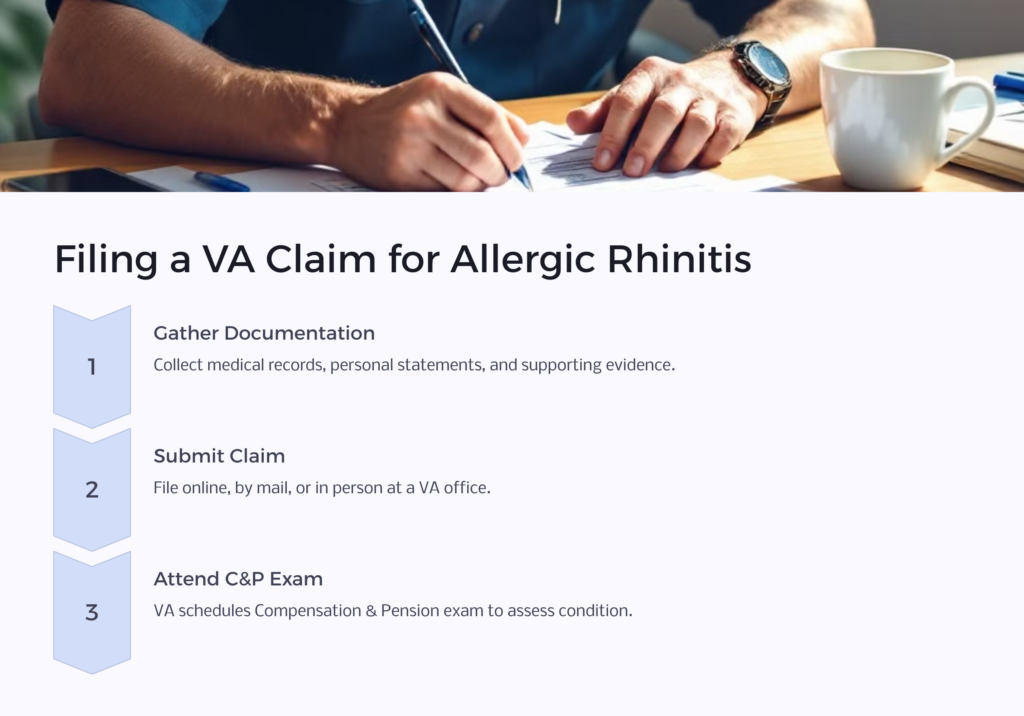What is Allergic Rhinitis?
Allergic rhinitis is inflammation of the inside of the nose caused by allergens such as pollen, dust mites, or pet dander.
You may hear allergic rhinitis called by other names, like “hay fever,” “nasal allergies,” or even “seasonal allergies.” Whatever you call it, the symptoms are the same: sneezing, itchy and watery eyes, and a stuffy or runny nose. While it’s not life-threatening, living with these allergy symptoms can make you pretty miserable. Complications like sinusitis or ear infections can arise if allergic rhinitis isn’t treated properly.
Veterans Affairs (VA) can provide disability compensation so long as you provide medical evidence that your allergic rhinitis has a service connection, such as burn pit exposure, and more. Filing a disability claim can help you receive disability compensation, whether to help pay for treatment or living day-to-day. Continue reading to learn about allergic rhinitis, rhinitis symptoms, and how to file your disability claim.
Symptoms of Allergic Rhinitis

Sneezing fits, an itchy or sore throat, fatigue, headaches, and irritability are common symptoms of allergic rhinitis.
You might notice dark circles under your eyes, called “allergic shiners,” which result from restricted blood flow near the sinuses. At times, allergic rhinitis can create or worsen other conditions.
So, how can you distinguish between allergic rhinitis and a common cold? A cold is caused by a virus, while allergic rhinitis is your body’s reaction to specific allergens, leading to allergy symptoms. If you notice that your symptoms flare up during certain times of the year—like spring or fall—chances are, it’s allergic rhinitis. Also, cold symptoms usually fade away within 7 to 10 days, whereas allergic rhinitis symptoms last as long as you’re exposed to the allergen. Different allergens can range from plants, pollen, food allergies, and more.
What Happens If Allergic Rhinitis Goes Untreated?
Untreated allergic rhinitis, especially chronic rhinitis, could complicate secondary conditions you may already have (like asthma). Delaying treatment might cost you more than just discomfort—it could impact other areas of your health. And remember, leaving a treatable condition unattended for veterans might lower your overall VA disability rating and, in turn, the benefits you’re eligible to receive.
Secondary Conditions Linked to Allergic Rhinitis
Allergic rhinitis is often part of a larger health picture because it can affect both your health and your claim. It can lead to or exacerbate other conditions, like asthma or chronic sinusitis. In some cases, it’s also linked to sleep apnea.
If you’re already rated for a primary condition and allergic rhinitis serves as a secondary issue, it can potentially increase your disability rating. Conversely, if allergic rhinitis is your primary concern but leads to secondary conditions—listen up—you may qualify for additional benefits.
Suppose you have allergic rhinitis and develop asthma. In this scenario, your asthma can be rated as a secondary condition, thereby affecting the total amount of benefits you receive. The takeaway? A solid understanding of the ripple effects of allergic rhinitis on your health can be advantageous when you’re interacting with the VA benefits system.
Potential Side Effects of Allergic Rhinitis

Chronic sinus infections and ear problems are common side effects, but it goes beyond that. Extended periods of discomfort, for instance, can disrupt your sleep, leading to fatigue and irritability. Beyond the physical, there’s also a mental toll; chronic symptoms can elevate stress levels and even contribute to anxiety or depression.
The VA Rating System for Allergic Rhinitis

In the United States, the Veterans Affairs (VA) rating for allergic rhinitis ranges between 0% and 30% (see this example of a winning case).
A 0% rating means symptoms don’t significantly interfere with your life. On the flip side, a 30% rating signifies a higher level of disability—constant sinusitis, for instance, or frequent episodes of headaches. And if your allergic rhinitis leads to secondary conditions, like asthma, you may also receive additional benefits for those conditions.
So, how do you get rated? First, you’ll need a formal diagnosis from a healthcare provider, typically via allergy tests or imaging like X-rays. Then, gather medical records, personal statements, and any other evidence that supports your claim. Just remember, accurate and complete documentation can make or break your case, so don’t skimp on the details.
How to File a Claim for Allergic Rhinitis with the VA

Navigating the VA system can feel like a maze. But fear not—filing a claim for allergic rhinitis doesn’t have to be complicated. Your first port of call? The VA’s official website. You can initiate a claim online, by mail, or in person at a VA office. Regardless of the method you choose, there are key components that your claim must include.
First and foremost, the all-important diagnosis. Make sure to include any relevant medical records from both military and civilian healthcare providers in your VA form. Also, lay out your case with a “nexus letter,” a medical professional statement connecting your allergic rhinitis to your military service or another service connected condition.
Then, submit your claim and hold tight. Once the VA receives your claim, they’ll schedule a Compensation & Pension (C&P) exam. Based on this exam and the submitted documentation in your VA form, the VA will determine your eligibility and disability rating. Though the process may take some time, a well-prepared claim can help expedite it.
Treatment Options: What’s Covered by the VA?
Treatment options for allergic rhinitis range from over-the-counter antihistamines, prescription allergy medicine, nasal spray, and even allergy shots. Fortunately, some of these treatments are covered by the VA.
Antihistamines and nasal sprays are commonly prescribed, and yes, they’re typically covered by the VA. Even better news—allergy shots, otherwise known as immunotherapy, a more long-term solution, may also fall under VA coverage. Immunotherapy involves regular injections that contain a small amount of the allergen; the goal is to help your body get used to it and eventually reduce your symptoms.
But there’s a catch; you need to have a proper diagnosis and your treatment plan must align with VA guidelines. In other words, don’t self-prescribe and assume the VA will pick up the tab. Consult a healthcare provider and make sure you’re following an approved treatment pathway.
Frequently Asked Questions about Allergic Rhinitis and VA Benefits
Can you file a claim for allergic rhinitis if you already have a different primary condition? Absolutely—you can file for it as a secondary condition.
How long does it take for a claim to be processed? Unfortunately, months or even years, but don’t give up: many veterans find the rating they need after a long struggle.
Can you appeal a denied claim?
You have the right to appeal a denied claim, and the VA will provide guidelines on how to proceed.
Are VA benefits taxable? The good news here—VA disability benefits are generally not considered taxable income.
Navigating these complexities can be daunting, but at Benefits.com we can answer questions and offer advice for allergic rhinitis VA benefits. For years, we’ve offered free counseling for many benefits claims to ensure that everyone gets the benefits they medically, ethically, and legally deserve. So stay informed, take action, and claim the VA benefits available to you.
 Benefits.com Advisors
Benefits.com Advisors
With expertise spanning local, state, and federal benefit programs, our team is dedicated to guiding individuals towards the perfect program tailored to their unique circumstances.
Rise to the top with Peak Benefits!
Join our Peak Benefits Newsletter for the latest news, resources, and offers on all things government benefits.


















